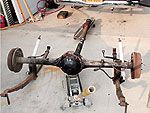
In reality, torque-tube rearends aren't all that bad when you think about it. OK, that may just apply to those who favor completely stock drivetrains in early pickups, but we're not here to discuss the advantages of factory components, as we've yet to find many. No, we're here to discuss the opposite--the advantages of ditching the old stuff in favor of the new, improved, and obviously better stuff out there specifically designed for our applications.
Case in point: Walton Fabrication's new parallel-leaf kit for '47-54 Chevy/GMC 1/2-tons. While these particular trucks came from the factory equipped with similar equipment, as we all know, leaf-over options don't leave you with many, well, options, especially if you're considering a stance adjustment or transmission swap. Albeit already lowered in the rear, this particular setup wasn't done favorably (unless you favor open-ended 5-inch steel tube lowering blocks, leaf-spring pads easily a couple inches below scrub, and some "creative" welding to boot). So, along with the obvious intent of relowering the truck correctly, the other objective was to address the torque tube--or rather, to address the ridding of the torque tube to make room for an open-drive rearend, to be more precise.
With future plans calling for a Tremec TKO five-speed in place of the old granny-geared factory transmission, it was mandatory that not only the rearend be swapped, but that it be swapped for one with a suitable ring-and-pinion ratio. Normally, anyone running a three-speed manual or automatic would most likely opt for something in the low 3s (a 3.00:1 is a pretty good all around gear for a regular cruiser). With an overdrive, you have room to breathe, so anything 3.50 and higher is recommended, especially if you're after some low-end grunt. With that in mind, a Dana 44 with a nice, short gear became available free of charge, and it happened to come out of a '52 Chevy 1/2-ton (so the work of flipping spring perches was already done...or so I figured), so it was the natural choice. Otherwise, options such as a '55-59 Task Force rearend or even a late-model Nissan Pathfinder were the next likely candidates. Also, I learned that a '55-59 1/2-ton third member will drop right in a '47-54 housing using the stock axles. I haven't researched this more in-depth, but someone may want to.
Now, with the issues of the rearend itself handled, it was just a matter of finding a ways to mount the Dana in the '53 chassis. As you've already seen by the title of the story, Walton Fabrication stepped up to the plate to handle that. Using all existing holes in the frame, their bolt-in leaf kit is literally that--bolt-in. With the exception of the spring pads, which need to be welded to the axle housing once positioned, everything from the spring hangers to the shock mounts bolt to the frame using holes previously occupied by factory rivets. Now, I won't lie--the rivets can put up a real fight, but once they're gone, you don't have to worry about them ever again, so a few hours (or more) spent grinding, drilling, and hammering isn't all that bad. As for the spring pads that were supposedly going to work, well, the Walton kit moves the leafs inboard a tad--enough so that only half of each leaf actually rested on the perches--so off they had to come. Initially, the kit was designed for leaf-overs that are still over, not guys who scarfed up a free rearend already modified! Nevertheless, the pads were carefully removed with the aid of a Sawzall and an angle grinder, followed by the placement of and subsequent welding of the new ones provided in the Walton kit (which actually afforded more drop due to their higher profile).
Welding and rearend housing straightening (highly recommended) aside, the remainder of the kit installation is a no-brainer. Tools to have at your disposal: a 1/2-inch electric or a good 1/4-inch pneumatic drill; an angle grinder with sufficient discs for not only grinding, but smoothing, as well; a hammer and punch set; an air ratchet; various handtools; and, of course, a good floor jack with even better jackstands. A full Saturday ought to serve as enough time for the job, especially considering the fact that it's not required to pull the bed off the frame (I did, but that was to allow better photo-taking abilities). The results should be indicated initially by the components of the kit itself: lower-profile/wider-width leaf springs with half the leaf pack versus stock; modern bushings and actual spring shackles; modern gas-charged shocks; and beefy, well-constructed brackets. On top of attaining a substantially better ride, you can expect a substantially lower stance, as well, which will depend on what size lowering blocks you choose, if any are used at all. Follow along and see how this anxious AD loses the tube...and gains a 'tude!